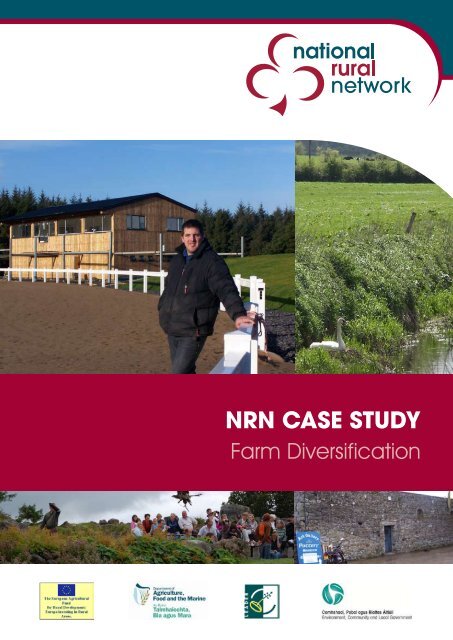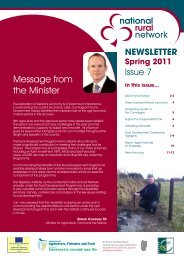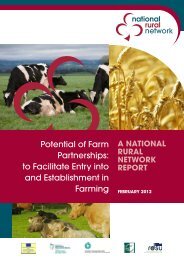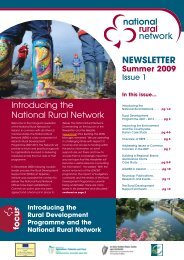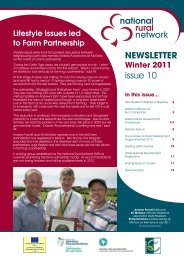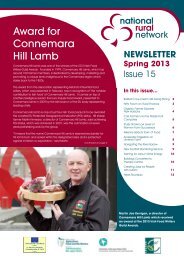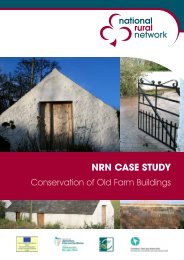Farm Diversification - National Rural Network
Farm Diversification - National Rural Network
Farm Diversification - National Rural Network
Create successful ePaper yourself
Turn your PDF publications into a flip-book with our unique Google optimized e-Paper software.
R<br />
N N<br />
NATIONAL<br />
RURAL NETWORK<br />
NATIONAL<br />
RURAL NETWORK<br />
R<br />
N N<br />
NATIONAL<br />
RURAL NETWORK<br />
NRN Case Study<br />
<strong>Farm</strong> <strong>Diversification</strong>
1. Introduction<br />
The quality of life in rural areas and diversification of the rural economy is the main focus of measures<br />
contained in Axis 3 (delivered through the LEADER programme by local development companies) of<br />
the <strong>Rural</strong> Development Programme 2007-2013. The diversification of mainstream farm activities into<br />
non-agricultural activities is an Axis 3 measure with the objective of stimulating and supporting the<br />
diversification of farm assets. At farm level this translates into the mobilisation of farm fixed assets into nonagricultural<br />
economic activity for economic gain by a member of the farm household.<br />
This case study is prepared on behalf of the <strong>National</strong> <strong>Rural</strong> <strong>Network</strong> (NRN). The objective of this study is<br />
to analyse farm diversification projects grant aided by Sligo <strong>Rural</strong> Development Partnership (SRDP) for the<br />
purpose of highlighting and disseminating good practice within the <strong>Rural</strong> Development Programme.<br />
2. <strong>Farm</strong> <strong>Diversification</strong> in Context<br />
<strong>Farm</strong> diversification is concerned with improving the capacity of the farm, or farm resources, to meet<br />
the immediate and future needs of the farm household 1 . This is achieved by widening the base of a<br />
farm business to include all the non-agricultural uses that available resources can be put to, or through<br />
any major changes in land use or level of production other than those related solely to agriculture.<br />
<strong>Diversification</strong> may be further defined as the entrepreneurial use of farm resources for a non-agricultural<br />
purpose for commercial gain 2 . This definition introduces the concept of entrepreneurship in diversification.<br />
Historically the production base of most Irish farms was diversified, producing everything from a range of<br />
cereals and root crops to livestock, pigs and poultry. Furthermore value was added to many products<br />
inside the farm gate and the marketing function was performed by the farm family who were involved in<br />
selling products such as potatoes, vegetables, butter and eggs to a local market. While these activities<br />
were generally confined to agricultural produce, they still required the farmer to engage in entrepreneurial<br />
activities and farm families possessed significant entrepreneurial skills.<br />
When Ireland joined the EEC in 1973 the Common Agricultural Policy (CAP) shaped a rapid change in<br />
farming practices from one of producing a range of diversified products to one of specialisation. With<br />
specialisation came structured markets and farmers became highly specialised producers, often at the<br />
cost of developing marketing and other entrepreneurial skills. While specialisation, linked to scale, is the<br />
way forward for many farm businesses, farm families will need to explore new income sources outside of<br />
mainstream agricultural production. The percentage of farm households with an off-farm job declined<br />
from 58% in 2007 to 51% in 2010 3 . The data also indicates that the value of off-farm work to farm<br />
households has also declined over the 2007-2009 period. This reflects both the loss of employment and<br />
cuts to the salaries of those with off-farm jobs. As all economic indications are that these trends are likely<br />
to continue for some time, an increasing number of farm households will need to examine internal farm<br />
and personal resources with a view to generating the income needed to meet future household needs.<br />
1<br />
Meredith, D. 2011, <strong>Farm</strong> <strong>Diversification</strong> in Ireland, Research Volume 6: Number 1, Spring 2011, ISSN 1649-8917, Teagasc, Ashdown, Dublin 15.<br />
2<br />
Department of Environment, Food and <strong>Rural</strong> Affairs, UK.<br />
3<br />
<strong>National</strong> <strong>Farm</strong> Survey, 2011, Teagasc.
3. <strong>Rural</strong> Development Policy<br />
From a policy perspective the stimulation and support of farm diversification is clearly enshrined in the<br />
<strong>Rural</strong> Development Programme under the Axis 3 measure ‘<strong>Diversification</strong> into Non-Agricultural Activities’. A<br />
total of €16.7 million of public funding has been allocated under this measure for the period 2007-2013.<br />
When matched by 50% private funding it will represent an investment of €33 million. The main objective of<br />
the measure is to “significantly increase the percentage of holdings where the fixed assets of the farm are<br />
utilised in any non-agricultural activity by the farm household”.<br />
Anecdotal evidence suggests that uptake under this measure is falling short of the targets outlined in the<br />
RDP. According to Meredith (2011), 5,000 farms in Ireland had some form of on-farm diversified enterprise<br />
in 2007 which equates to slightly less than 4% of farms in the country. This compares to 51% of English<br />
farms with a diversified enterprise in the same year. While extraneous factors such as farm structure,<br />
population densities and the availability or otherwise of industrial/commercial workspace in rural areas<br />
may contribute to this variance, it may not be the full answer. Restriction on the availability of credit for<br />
matching funding is also quoted anecdotally as a factor in the current climate.<br />
4. Description of Case Studies<br />
This study examines diversification on three farms across County Sligo (Drumcliff, Corballa, and Ballymote).<br />
The families on these farms all demonstrated entrepreneurial initiative in the mobilisation of land, buildings,<br />
labour, capital and individual enterprise.<br />
The Branley family has been farming 81 acres in Drumcliffe since 1996. The farmhouse, (featured in<br />
“Heritage Houses of Sligo”) and traditional out-buildings are of local stone. Michael worked as a carpenter<br />
before coming home to join his father Chris in the business. Traditionally a suckler and sheep farm they<br />
now keep a ewe flock, which Chris says is more suited to the soil type on the farm. Michael and Chris have<br />
converted the traditional stone outhouses into 25 craft units operating under the brand name of ‘Branley’s<br />
Yard’. The businesses in these units currently employ approximately thirty people. Michael and Chris plan to<br />
open a coffee shop in 2012 and have planning permission for a farmers’ market and large car park. They<br />
are also developing a nature walk from the yard down to the sea; the walk incorporates a ring fort and<br />
geological feature. Michael and Chris were granted aid under the LEADER programme for converting the<br />
buildings and hope to apply for a marketing grant in 2012.
Jonathan Reape and his father John farm 120 acres in Corbala. The Reapes traditionally farmed beef<br />
cattle, sheep and horses. They gradually increased horse numbers dropping the beef enterprise but<br />
retaining the sheep flock. According to Jonathan “sheep and horses go very well together, the sheep<br />
clean up grassland after the horses”. Jonathan buys young horses, breaks and trains them and sells them<br />
on, mostly to international customers in the show jumping market. John built an indoor arena to facilitate<br />
working on the horses on a year-round basis and Jonathan joined his father in the business when he<br />
finished secondary school. Jonathan identified a gap in the market for an outdoor show-jumping arena<br />
built to international standards together with a clubhouse and associated facilities. “There is nowhere with<br />
these facilities in the north-west; we have to go to places like Barnadown in Wexford to take part in events<br />
and show our horses at this level”. Jonathan was grant-aided under the LEADER programme for the clubhouse,<br />
viewing area and shower/toilet facilities.<br />
Lothar Muschketat and his wife moved from Germany to Corbala where he purchased 67 acres of land<br />
and set up the Irish Raptor Research Centre in 1999. Lothar, formally a zoology lecturer, keeps 350 birds<br />
and animals including 75 species and specialising in birds of prey. The family welcomes visitors to the<br />
centre where a live educational show is put on<br />
twice a day from March to October. The centre,<br />
with outdoor seating for 500 people (indoor 250),<br />
operates under the brand name ‘Eagles Flying’<br />
and received the accreditation of EU ZOO in<br />
2007. The centre co-operates with international<br />
zoos breeding endangered species for reintroduction<br />
programmes and offers placements<br />
to students in the discipline. Lothar received<br />
funding under the LEADER programme on two<br />
occasions for bird housing and toilet facilities.<br />
All three examples have diversified the utilisation<br />
of farm based resources for non-agricultural<br />
commercial use. Lessons can be learned from<br />
the experiences of all these families which<br />
are relevant to a wider target group of farm<br />
households.
5. Analysis of Outcomes<br />
While several recurring themes emerged, individual practices were varied and reflected previous<br />
behaviour and attitudes.<br />
5.1 Motivation for Diversifying<br />
Increasing income was a factor but<br />
it was not the sole motivator; in fact<br />
lifestyle preferences and previous<br />
experiences were the main drivers. In<br />
both Michael and Jonathan’s case<br />
diversification was not a ‘major event’<br />
but rather a gradual move from<br />
traditional mainstream production<br />
towards “something different”. In<br />
Michael’s case his father Chris had<br />
converted two of the outhouses into<br />
accommodation units many years<br />
previously. So as Michael put it, “the<br />
seed had been sown”. Jonathan<br />
had grown up around horses, had<br />
developed a keen interest in the<br />
business and had acquired relevant<br />
knowledge and skills before any major<br />
investment was undertaken. Both<br />
businesses grew organically which<br />
would suggest that previous knowledge and experience is a key success factor. While Lothar’s motivation<br />
was primarily a lifestyle choice - “I’m not stressed out any more” - he did not perceive the venture to be a<br />
hobby and displayed a keen sense of commercial awareness.<br />
5.2 Entrepreneurship and Innovation<br />
The French economist J.B. Say stated that ‘the entrepreneur shifts economic resources out of an area<br />
of lower and into an area of higher productivity and greater yield’ 4 . In the examples presented, the<br />
physical resources such as land and buildings were redeployed into the new ventures. All of the 25<br />
craft units in Branley’s Yard were converted from existing outhouses and the plans to develop a nature<br />
walk incorporating natural archaeological and geological features is further evidence of resource<br />
redeployment. As stated by the Branleys, “the income from the units may be low but it’s still ten times<br />
better than cattle”. All of Lothar’s land is employed in the business and a converted building is now an<br />
indoor educational centre. From a resource employment perspective, all of the families involved were<br />
behaving in an entrepreneurial fashion.<br />
The concept of innovation and innovative behaviour is embedded in the guiding principles of the LEADER<br />
approach. Innovation requires a unique product offering in a geographical area relevant to the market<br />
for that product. All of the participants were offering a unique product mix in Sligo “we have clients in the<br />
units from different parts of the country and some from other countries” and “there’s nothing in this part of<br />
the country to attract international show jumpers”.<br />
5.3 Marketing & Management<br />
Word of mouth and understanding the needs of the clients (in the craft units) are both critical marketing<br />
tools for Branleys; “the craft community is relatively small and word gets around, we treat our clients well<br />
and make it as easy as possible for them…we always had a waiting list”. The market for the coffee shop<br />
4 <br />
Drucker, P.F., (1996) Innovation and Entrepreneurship, Pubs. Butterworth-Heinemann, Linacre House, Jordan Hill, Oxford, OX2 8DP,<br />
ISBN 0 7506 1908 2.
will be drawn from a passing trade and the proximity of Branley’s yard to Drumcliff (Yeats Visitor Centre) is<br />
a major marketing advantage. Jonathan’s market is based on personal contacts and networking within<br />
the industry but he is planning to apply for LEADER funding to draw up a marketing plan for the new facility.<br />
The ‘Eagles Flying’ web site, a brochure and direct communication with incoming tour operators were<br />
the tools Lothar used to communicate with the market. Management was not perceived as an issue as<br />
numbers employed were low. Time management was, however, of some concern. All stress the important<br />
role family members play in the management of their businesses.<br />
5.4 Business Growth<br />
All the participants anticipated business growth even in the current economic climate. Eagles Flying<br />
employs six people full-time during the season. There are currently 30 people (mostly self-employed) in<br />
Branley’s yard. Jonathan expects to generate significant economic activity in the local area on weekends<br />
when events are taking place; “we expect to have up to 150 families at events here and that will generate<br />
a lot of activity locally”.<br />
5.5 Role of LEADER and the <strong>Rural</strong> Development Programme<br />
Michael and Jonathan agreed that LEADER support was critical to the development of their businesses<br />
and all stressed that the personnel they were dealing with were extremely helpful and informative.<br />
However all found ‘the level of paperwork heavy going’. There was a belief that those evaluating projects<br />
should have specialist knowledge of the project area or have the facility to consult with an advisor with<br />
specific expertise. It can be a challenge for board members to understand the complexities of some<br />
new innovations. Raising matching funding is an issue and some felt caught between the bank and the<br />
agency; the bank will not approve a loan until grant approval is received and the agency will not approve<br />
the grant until bank loan approval. Young farmers who might have good ideas may not have the tenacity<br />
to cross funding hurdles and funding may be more accessible to business people who are experienced in<br />
these processes.
6. Critical Success Factors<br />
and Barriers<br />
Personal characteristics of individual promoters contribute to the capacity of the household to redeploy<br />
resources; these range from having a positive attitude, a strong work ethic, relevant previous<br />
work experience and a ‘love of the work’. The fact that all participants had relevant experience outside<br />
mainstream agricultural production is evidence of the role of such previous experience in the successful<br />
establishment of a business of this nature.<br />
Innovative aspects of the business enable a promoter to serve a gap in the market and avoid direct<br />
competition. Innovation does not mean a brand new technology, product or service but some aspect of<br />
the product or service must be new to the market in a geographic area.<br />
Appropriate marketing and effective management is an important factor. Where the service is delivered<br />
to a local market, location and proximity to a widely publicised visitor centre will contribute to the success.<br />
Understanding customer needs as evidenced in the relationship with the craft clients is also a factor.<br />
Understanding the nature and importance of marketing is critical to any new rural business. Effective<br />
management is also important to long-term sustainability.<br />
Institutional support is a significant success factor. Two participants cited the LEADER grant as a critical<br />
factor in the establishment of the business while the third participant cited this as important but not critical.<br />
This is evidence that seed funding such as LEADER funding is critical to the success of new diversified farm<br />
businesses.<br />
The main barriers to success identified were:<br />
● The level of paperwork and bureaucracy involved in the grant application process. This was highlighted<br />
as a particular barrier for many farmers.<br />
● The lack of awareness of the importance of and knowledge of good marketing.<br />
● The availability of bank credit for matching funding.<br />
● In general terms the mindset of many farmers, fuelled by a lack of experience outside of mainstream<br />
agricultural production, is a barrier to the establishment of diversified farm based enterprises.<br />
● Increasing local authority charges as evidenced in relation to increased water rates.
7. Links to <strong>Rural</strong> Development<br />
Programme<br />
It is evident that linkages and complementarities do exist both vertically and horizontally at Axis level. While<br />
some of these linkages are explicit others may be implied across the axes. All of the participants benefited<br />
under the <strong>Farm</strong> Waste Management Scheme (or its predecessors). “The business opportunity here kind of<br />
came about by accident; as a result of building the slatted shed, the old out-buildings became obsolete<br />
and we wanted to do something with them. I had the idea for a long time but couldn’t do anything while<br />
the cattle were in the yard”. When Jonathan Reape decided to join his dad in the equine business he<br />
first completed the Teagasc Green Cert. “This was great because it helped me to realise that we had to<br />
develop the horses if I was to make a living on this farm; a lot of the other lads on the course wanted to<br />
carry on farming as usual”.<br />
While Lothar Muschketat didn’t avail of any funding under the agri-environmental measure his organic<br />
‘back to nature’ land management system is contributing to the objectives under this measure. “We’re<br />
completely sustainable here, the sheep are our lawnmowers”. The Branleys hope to be eligible for some<br />
funding for the development of the nature walk on their farm and this development will also support the<br />
objectives of this measure. All participants are in the REPS scheme. It is valid to infer that farmers who<br />
move into market led businesses will, by nature and necessity, become more competitive both in their<br />
mainstream activities and in their diversified businesses and as these ventures increase it will significantly<br />
increase overall competitiveness.<br />
Horizontal complementarities were also identified within the Axis 3 measures. The main objective of the<br />
<strong>Farm</strong> <strong>Diversification</strong> Measure is to increase the number of holdings where the farm assets are utilised in<br />
non-agricultural activity for economic gain. The three diversification businesses examined in the study<br />
comply directly with this objective as redeployment of resources is a requirement of diversification.<br />
There are also direct linkages and complementarities between the diversification and business creation<br />
measures.<br />
There are opportunities for further linking farm diversification participants with, for example, County<br />
Enterprise Boards (CEB) for follow-up small business management and marketing training and with<br />
Chambers of Commerce. Anecdotal evidence would suggest that farmers who set up diversified<br />
businesses feel isolated from both business networks and farming networks. All of the participant ventures<br />
also display direct links with the rural tourism measure. Branley’s Yard is directly linked into the local<br />
tourism market and contributes significantly to the ‘bundle of tourism services’ available to tourists in that<br />
geographic area. ‘Eagles Flying’ and Jonathan Reape’s show jumping facility are also both contributing<br />
to the tourist market in their respective areas. Unlike Branley’s Yard both of these businesses are operating<br />
in remote areas away from any tourist ‘hot spot’. This implies that more intensive efforts will be required to<br />
communicate with their target market. The study also identified direct links between Branley’s Yard, with<br />
its sensitively restored farm buildings and the objectives set out under the rural heritage measure. The<br />
proposed nature walk will further feed into this objective.<br />
It is evident from this study that there are both internal and external linkages and complementarities at<br />
Axes level. This in turn confirms that there are potential synergies within the programme.
8. Lessons Learned and Conclusions<br />
Due to the increasing role of economies of scale in mainstream farming combined with a reduction in<br />
off-farm employment opportunities, many farm households will need to explore new ways of employing<br />
farm assets if they wish to continue to operate their farms and enjoy a rural lifestyle. Funding allocated<br />
under the <strong>Farm</strong> <strong>Diversification</strong> Measure acts as a stimulus to this type of development in rural areas and<br />
offers significant, and often critical support to the farm household in its endeavour to diversify. <strong>Farm</strong>ers who<br />
move into market-led businesses will, by nature and necessity, become more competitive both in their<br />
mainstream activities and in their diversified businesses and as the number of these ventures increase it will<br />
significantly increase competitiveness in the sector and in the rural economy.<br />
Previous experience was identified as a factor in the successful establishment and growth of a diversified<br />
business. The study findings indicate that those with work experience, relevant to the new venture, either<br />
inside or outside the farm are more likely to venture than those who lack this experience. The household’s<br />
perception of risk will be heightened if no member has any experience other than mainstream production.<br />
This risk may be moderated by targeted training, exposure to farm diversification such as field trips to<br />
diversified farms and discussions with farm based entrepreneurs.<br />
The study also identified the importance of entrepreneurial characteristics and abilities in the successful<br />
establishment and growth of a diversified business. Characteristics such as having a positive attitude,<br />
self-belief, strong work ethic, commitment and determination were all evident in the study. Abilities to be<br />
innovative, identify market opportunities and re-deploy and mobilise the necessary resources to establish<br />
and build a business were likewise evidenced in the study.<br />
Word of mouth, personal contacts, location exploitation and limited use of print and web based media<br />
were the main marketing tools employed. Market research was conducted by obtaining feedback from<br />
clients/visitors. Two of the three promoters planned to seek funding towards the preparation of marketing<br />
plans and materials. It is clear from discussions that more knowledge and expertise was needed in the<br />
marketing of their businesses, though even in the current economic climate all promoters expected to<br />
grow their business and envisage positive downstream effects on other economic activity in their areas.<br />
While LEADER funding was a very important factor in the establishment of the businesses there was a<br />
strong belief that the ‘level of paperwork’ involved was both onerous and time consuming and should<br />
be simplified while still assuring accountability and good practice. All of the promoters emphasised the<br />
helpful role played by the LEADER representatives throughout the process. It was, however, suggested that<br />
Board members should have access to specialist knowledge in the project area when making funding<br />
decisions.
9. Recommendations<br />
While this study identified some of the factors that inhibit the uptake of funding under the <strong>Farm</strong><br />
<strong>Diversification</strong> Measure, more research should be conducted to examine: projects/promoters that received<br />
funding but whose businesses were ultimately unsuccessful; unsuccessful funding applicants; and those<br />
that have never applied. This research would identify barriers at both conceptual and application stages,<br />
clarify those factors that contribute to success and contribute to building a profile of the ‘successful farmbased<br />
entrepreneur’.<br />
There is a need for more business and enterprise training for farm household members to encourage them<br />
in the adoption process. Training courses and seminars contribute to the stimulation of awareness and<br />
interest in diversifying. Field trips and discussions encourage trial and, if other factors are favourable, can<br />
lead to adoption.<br />
It is critical that LEADER staff and those serving on evaluation committees have, or have access to,<br />
knowledge and expertise relating directly to the specific project being evaluated. This could minimise the<br />
risk of failure while at the same time ensuring that innovative proposals do not slip through un-supported<br />
due to a lack of understanding of the specific context. There is a case for facilitating project promoters,<br />
particularly of large projects, to make a presentation to an evaluation committee or an individual with<br />
relevant expertise in the specific sector, in order to demonstrate their capacity to deliver the project.<br />
<strong>Farm</strong> based businesses need the same management, marketing and training support as other business<br />
start-ups, since many promoters don’t appreciate the value of a professional marketing approach in a<br />
competitive market environment. In this context there are opportunities for linking applicants under the<br />
<strong>Farm</strong> <strong>Diversification</strong> Measure with, for example, County Enterprise Boards (CEBs) for follow-up small business<br />
management and marketing training to sharpen promoter’s marketing and management skills. Links should<br />
also be established with Chambers of Commerce as anecdotal evidence suggests that farmers who set<br />
up diversified businesses can feel isolated from both their original farming networks and from business<br />
networks.<br />
There is a need for regular and consistent examination and analysis of the systems and procedures<br />
involved in the grant application process. It is accepted that there must be complete accountability<br />
but efforts should be made to devise a more user-friendly and paperless process while still meeting<br />
accountability requirements. Staff that interact directly with project promoters should be involved in<br />
consultative processes on optimising delivery of the programme<br />
If the objectives stated in the RDP in relation to farm and rural economic diversification are to be achieved<br />
in the longer term, then it is of great importance that this measure is replicated, even if with modifications,<br />
in any future <strong>Rural</strong> Development Programme.<br />
10
This case study was prepared for the NRN by Ms Lily Mulhall.<br />
Editing was undertaken by Mr Ciaran Lynch and Dr Pat Bogue, NRN.<br />
For further information, contact nrn@lit.ie


